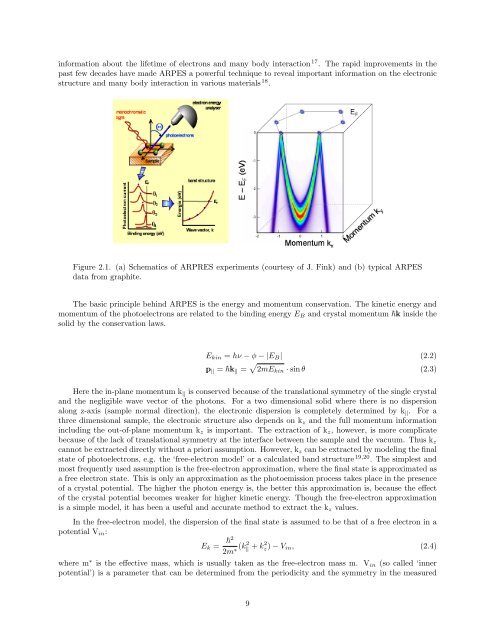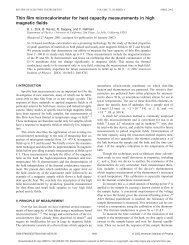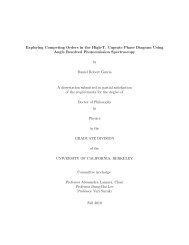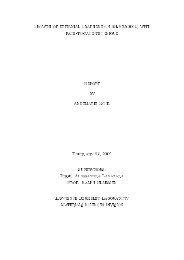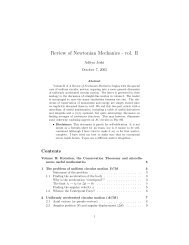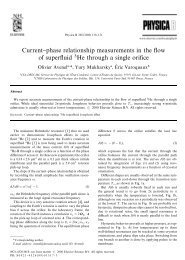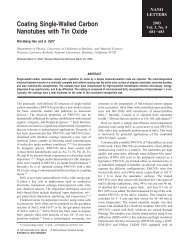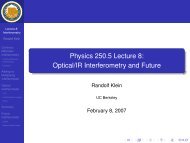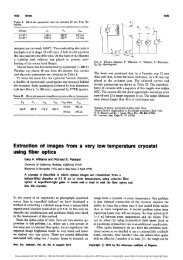Dirac Fermions in Graphene and Graphiteâa view from angle ...
Dirac Fermions in Graphene and Graphiteâa view from angle ...
Dirac Fermions in Graphene and Graphiteâa view from angle ...
Create successful ePaper yourself
Turn your PDF publications into a flip-book with our unique Google optimized e-Paper software.
<strong>in</strong>formation about the lifetime of electrons <strong>and</strong> many body <strong>in</strong>teraction 17 . The rapid improvements <strong>in</strong> the<br />
past few decades have made ARPES a powerful technique to reveal important <strong>in</strong>formation on the electronic<br />
structure <strong>and</strong> many body <strong>in</strong>teraction <strong>in</strong> various materials 18 .<br />
Figure 2.1. (a) Schematics of ARPRES experiments (courtesy of J. F<strong>in</strong>k) <strong>and</strong> (b) typical ARPES<br />
data <strong>from</strong> graphite.<br />
The basic pr<strong>in</strong>ciple beh<strong>in</strong>d ARPES is the energy <strong>and</strong> momentum conservation. The k<strong>in</strong>etic energy <strong>and</strong><br />
momentum of the photoelectrons are related to the b<strong>in</strong>d<strong>in</strong>g energy E B <strong>and</strong> crystal momentum k <strong>in</strong>side the<br />
solid by the conservation laws.<br />
E k<strong>in</strong> = hν − φ − |E B | (2.2)<br />
p ‖ = k ‖ = √ 2mE k<strong>in</strong> · s<strong>in</strong> θ (2.3)<br />
Here the <strong>in</strong>-plane momentum k ‖ is conserved because of the translational symmetry of the s<strong>in</strong>gle crystal<br />
<strong>and</strong> the negligible wave vector of the photons. For a two dimensional solid where there is no dispersion<br />
along z-axis (sample normal direction), the electronic dispersion is completely determ<strong>in</strong>ed by k ‖ . For a<br />
three dimensional sample, the electronic structure also depends on k z <strong>and</strong> the full momentum <strong>in</strong>formation<br />
<strong>in</strong>clud<strong>in</strong>g the out-of-plane momentum k z is important. The extraction of k z , however, is more complicate<br />
because of the lack of translational symmetry at the <strong>in</strong>terface between the sample <strong>and</strong> the vacuum. Thus k z<br />
cannot be extracted directly without a priori assumption. However, k z can be extracted by model<strong>in</strong>g the f<strong>in</strong>al<br />
state of photoelectrons, e.g. the ‘free-electron model’ or a calculated b<strong>and</strong> structure 19,20 . The simplest <strong>and</strong><br />
most frequently used assumption is the free-electron approximation, where the f<strong>in</strong>al state is approximated as<br />
a free electron state. This is only an approximation as the photoemission process takes place <strong>in</strong> the presence<br />
of a crystal potential. The higher the photon energy is, the better this approximation is, because the effect<br />
of the crystal potential becomes weaker for higher k<strong>in</strong>etic energy. Though the free-electron approximation<br />
is a simple model, it has been a useful <strong>and</strong> accurate method to extract the k z values.<br />
In the free-electron model, the dispersion of the f<strong>in</strong>al state is assumed to be that of a free electron <strong>in</strong> a<br />
potential V <strong>in</strong> :<br />
E k =<br />
2<br />
2m ∗ (k2 ‖ + k2 z) − V <strong>in</strong> , (2.4)<br />
where m ∗ is the effective mass, which is usually taken as the free-electron mass m. V <strong>in</strong> (so called ‘<strong>in</strong>ner<br />
potential’) is a parameter that can be determ<strong>in</strong>ed <strong>from</strong> the periodicity <strong>and</strong> the symmetry <strong>in</strong> the measured<br />
9


